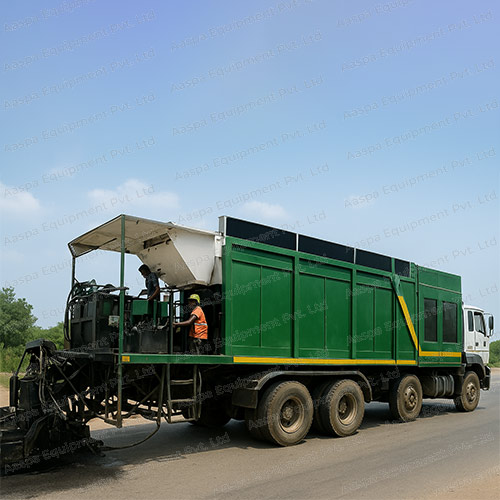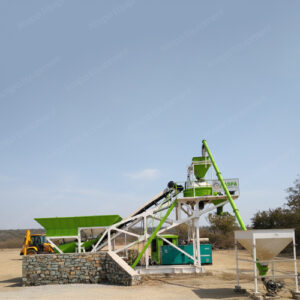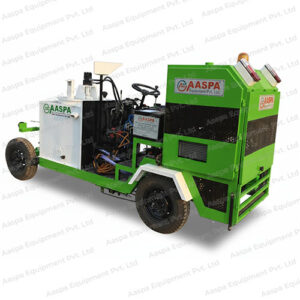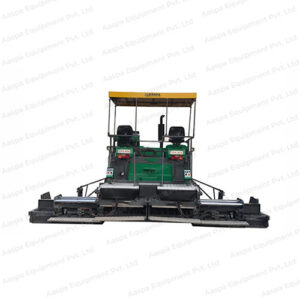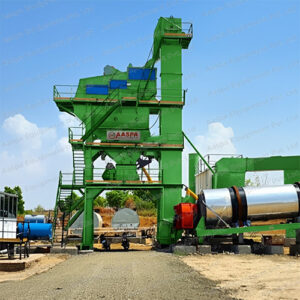Microsurfacing Machine
Microsurfacing Machine
Aaspa Equipment Pvt Ltd presents a state-of-the-art Microsurfacing Machine, engineered for modern road maintenance and surface treatment. This machine provides a quick, economical, and eco friendly solution to restore road conditions, improve skid resistance, and extend pavement life.
- Uniform Surfacing – Ensures smooth and consistent application.
- Durable Performance – Designed for long-lasting road protection.
- Advanced Technology – Equipped with precision controls for accuracy.
- Cost-Effective – Reduces maintenance costs with minimal traffic disruption.
- User-Friendly Operation – Easy handling and efficient working.
Technology Benefits
•Waterproofs road surface improves skid resistance
•Seals cracks and allows minor profile corrections
•Prevents potholes and patches
•No disturbance to underground utilities or thermoplastic markings
•Cold applied, reducing energy consumption
•Quicker road reopening with short closures
•Cost-effective compared to hot mix asphalt overlay
•Reduces lifecycle costs and extends road lifespan
•Practical operator console for clear view
•Bi-directional joysticks and hand levers for ease
• Instant display of material consumption rates
•Fully expandable hydraulic spreader box for flexible width laying
•SCADA-based automation for precision control and reporting
•Automation system for precision control and comprehensive reporting.
•Environmentally friendly cold application
•Reduced energy consumption
•Zero emissions target
Material Testing
Before application, the materials used in the microsurface undergo comprehensive testing. This includes evaluation of asphalt emulsion, aggregate, mineral filler and their compatibility.
In-Process Inspection
During application, technicians carefully monitor the process to ensure uniform application thickness, correct texture and proper curing.
Post-Application Assessment
After the microsurfacing is complete, a thorough assessment ensures that the road surface meets all specifications and quality standards. Any necessary repairs are made immediately
Long-Term Monitoring
Quality assurance extends beyond the day of application. Long-term monitoring ensures that the road maintains its performance and durability for the years..
Technical Specifications
| MACHINE MODEL | SURFACE 8000 | SURFACE 12000 |
| Laying Per Trip | upto 1500 m2 | upto 2300 m2 |
| Aggregate Hopper Capacity (without heap) |
8 m3 | 12 m3 |
| Aggregate Hopper Capacity (with heap) |
9.6 m3 | 15 m3 |
| Emulsion Tank Capacity | 2500 L | 4000 L |
| Water Tank Capacity | 3000 L | 5000 L |
| Cement Hopper Capacity | 600 Kg | 600 Kg |
| Additive Tank Capacity | 300 L | 500 L |
| SECTIONS | |
| Screed Type | Hydrostatic Expandable Screed |
| Additive Tank Type | Pressurized Tank-Stainless Steel |
| Slurry Discharge Gates | Pneumatically operated triple gate system |
| Dosing Systems | Digital Electro-magnetic Flow meters |
| Mixer | Twin Shaft Mixer with slope compensation |
| Operating System | PLC Operating System |
| Glass Fibre Addition | Optional Equipment |
Microsurfacing on Concrete Roads
Why Choose Microsurfacing for Asphalt Roads?
Smoother Finish: Improves surface uniformity for a better driving experience.
Longer Lifespan: Protects the surface from wear and tear, extending its life.
Why is Microsurfacing Needed?
Corrective Maintenance: Microsurfacing is used to fill ruts, repair wheel path ruts, apply scratch courses over ravelled surfaces, or create a leveling course to improve cross-sectional drainage.
What Is Microsurfacing?
Corrective Maintenance: Microsurfacing is used to fill ruts, repair wheel path ruts, apply scratch courses over ravelled surfaces, or create a leveling course to improve cross-sectional drainage.
What Is Microsurfacing?
Ingredients
Understanding this begins with its basic components. The polymer modified asphalt emulsion plays a key role in providing durability, while crushed aggregate contributes to the texture of the surface. Mineral filler enhances adhesion, and water is used to control viscosity. The combination of these elements creates a flexible yet smooth driving surface.
The Evolution of Road Construction
Microsurfacing vs. Chip Seal: A Comparative Analysis
The Battle of Surface Treatments
Chip seal is a well-established surface treatment that involves applying a thin layer of aggregate over an asphalt surface. This technique provides improved skid resistance and sealing capabilities, making it suitable for variety of road conditions. However, microsurfacing comes with its own set of advantages that set it apart.
Microsurfacing’s Upper Hand
Microsurfacing boasts the remarkable ability to address a wider range of road surface issues. It can correct ruts, cracks, and even minor potholes. Additionally, it offers a smoother, more skid-resistant surface compared to chip seal. While chip seal certainly has its merits, the versatility of microsurfacing often makes it the preferred choice.
To address these challenges, specialized bitumen storage tanks areemployed
The Microsurfacing Machine: A Marvel of Engineering
Behind the scenes of the seemingly seamless execution of this machine lies the heart of the operation: the microsurfacing machine. This technical marvel plays a vital role in the precise application of microsurfacing materials and ensures a uniform and high-quality result.
The Microsurfacing Machine’s Anatomy
A microsurfacing machine consists of several complex components, all designed to work in harmony. The primary components include the aggregate feeder, emulsion tank, mixing unit and application system. Each part of the machine has a specific role, ensuring the mixture is applied consistently to the road surface.
Understanding the Procedure
Surface Preparation
The journey begins with thorough surface preparation. This includes cleaning the roadway to remove dirt, debris and other debris. Any existing damage or defects in the pavement are repaired, providing a smooth surface for the microsurfacing application.
Application
Custom microsurfacing is a precise process. In this step, the microsurfacing machine plays a key role as it precisely applies the
compound to the road surface. Application thickness is carefully controlled to ensure optimal results.
Curing and Traffic Return
After the micro-surfacing material is applied, it undergoes a curing process. During this time, the surface gains strength and resistance. Once the curing period is complete, road traffic can be resumed, minimizing disruption.
Quality Control and Inspection
To maintain the highest standards, quality control and inspection are an integral part of the microsurfacing process. Technicians monitor and assess the application to ensure it meets all specifications and requirements.
Benefits of Microsurfacing Machine for Road Construction
Enhanced Skid Resistance
One of the main advantages of microsurfacing is its ability to increase skid resistance. The surface becomes less slippery, which reduces the risk of accidents and improves overall road safety.
Quick Return to Service
Unlike more invasive road construction methods, microsurfacing allows for a quick return to traffic. After the curing process is complete, operations can resume without extended closures.
Pothole and Crack Repair
Microsurfacing is effective in dealing with common road problems, including minor potholes and cracks. By sealing and leveling the surface, it prevents these problems from getting worse.
Environmental Benefits
A significant advantage of microsurfacing is environmental friendliness. It reduces waste and emissions compared to other road construction methods, which is in line with the global push for sustainable infrastructure development.
Reduced Pavement Deterioration
The application of microsurfacing creates a protective layer on the road, shielding it from the elements and preventing premature deterioration. This results in a longer lifespan for the road.
Addressing Common Road Construction Problems
Rutting
Rutting, the formation of depressions or grooves in the road surface, can be a significant issue in high-traffic areas. This machine effectively corrects rutting, restoring a smooth driving surface.
Surface Wear
Gradual wear of the road surface can be solved using micro surfaces. It rejuvenates the road and provides vehicles with a fresh and anti-slip surface.
Cracking
Cracks in the road surface are not only unsightly but can also lead to more extensive damage if left unattended. Microsurfacing fills and seals these cracks, preventing water infiltration and further deterioration.
All-Weather Performance
It’s all-weather performance makes it a versatile solution for roads in a variety of climates. Whether you’re facing extreme cold, intense heat, or heavy rain, microsurface roads withstand the elements.
Potholes
Potholes are a notorious road problem. Microsurfacing repairs minor potholes and prevents them from reoccurring, ensuring a safer and more comfortable driving experience.
PAS: Problem-Agitate-Solution in Road Construction
Identifying Road Issues
When implementing a PAS approach, road construction professionals first identify problems affecting a particular road. This can include problems such as surface wear, ruts and cracks.
Agitating the Problem
Once a problem is identified, it is essential to agitate or highlight its importance. Road condition can affect safety, driving time and overall road quality, making the problem more obvious and urgent.
Presenting the Solution
The final step is to introduce the solution, which in many cases is a microsurface. The PAS approach effectively communicates the benefits of this method in solving problems on the road and offers an excellent driving experience.
The Environmentally-Friendly Aspect of Microsurfacing
In a world increasingly focused on environmental sustainability, microsurfacing is emerging as an environmentally friendly option for road maintenance. This section delves into the environmental benefits and how it aligns with the broader goals of sustainable infrastructure development.
Reducing Waste
Microsurfacing minimizes waste through efficient use of materials. As a cold mix technology, it does not require the high temperatures associated with hot mix asphalt, reducing energy consumption and emissions.
Lower Carbon Footprint
Reduced energy consumption and emissions during the production and application of microsurfacing materials contribute to a lower carbon footprint, which is in line with global environmental goals.
Extended Road Lifespan
By preserving and protecting the road surface, microsurfacing extends the life of the road. This means fewer construction and maintenance cycles, further reducing the environmental impact.
Water-Based Emulsions
This machine primarily uses water-based asphalt emulsions, reducing the
use of petroleum-based products and their associated environmental
impact.
Application of Cold Mix Technology Worldwide
Microsurfacing machine, as a part of cold mix technology, is not limited by geographical boundaries. It has made its mark on road construction projects around the world. This section examines real examples of its successful applications and shows its adaptability in different climates and conditions.
North America
In North America, microsurfacing is widely used for road maintenance and rehabilitation. The method’s ability to withstand harsh winters and extreme temperature swings makes it a preferred choice.
Europe
European countries, with their focus on sustainability and environmental friendliness, have adopted microsurfacing. It is in line with their emission reduction and resource conservation goals.
Asia
Microsurfacing machine is gaining ground in Asian countries as well. The versatility of this method in solving road problems in different climatic and traffic conditions makes it an attractive choice.
Global Adoption
The global adoption of microsurfacing means its success in a variety of settings. Its applicability to various types of roads, from city streets to highways, demonstrates its versatility.
Maximizing the Lifespan of Microsurfaced Roads
The application of microsurfacing is a proactive step to maximize the life of roads. This section provides an overview of maintenance strategies and practices that help extend the life of microsurface roads.
Regular Inspections
Frequent inspections help identify the first signs of wear or damage. Addressing these problems early can prevent them from getting worse.
Timely Repairs
repairs can prevent them from growing into larger problems.
Routine Maintenance
Routine maintenance, such as street cleaning and debris removal, contributes to the longevity of microsurface roads.
Surface Restoration
Periodic resurfacing, where a new micro-surfacing layer is applied, can refresh the roadway and further extend its life.
Cost Efficiency and Economic Impact
In an era of tight budgets and economic considerations, microsurfacing stands out as a cost-effective road maintenance solution. This section delves into the economic benefits and long-term savings it offers.
Cost-Effective Maintenance
Microsurfacing is an economical choice for road maintenance. Its effectiveness in solving various problems minimizes the need for costly repairs and renovations.
Long-Term Savings
The extended service life of micro-surfaced pavements leads to long-term savings. Fewer maintenance cycles and lower repair costs translate into significant economic benefits.
Minimal Disruption
Microsurfacing’s fast cure time reduces road closures and traffic disruptions, further saving time and resources.
Sustainability
The reduced environmental impact of micro-surfaces is in line with sustainability goals and potentially opens up additional funding opportunities.
Challenges
While microsurfacing offers several advantages, it is not without challenges. In this section, we openly discuss the barriers to implement this technology and explore possible solutions.
Weather Conditions
Adverse weather conditions can affect the application of the micro-surface. Cold or wet weather may require modification of the procedure
Traffic Management
Traffic management during the application process is critical. Closures and detours must be well planned to minimize disruption.
Surface Preparation
Proper surface preparation is critical to the success of microsurfacing. Solving existing problems on the road and cleaning the surface is time consuming but necessary.
Skilled Workforce
Microsurfacing requires a skilled workforce for effective application. Training and certification are essential to maintain quality.
Conclusion: Paving the Future with Cold Mix Technology
In conclusion, cold mix technology, especially microsurfacing, represents a fundamental shift in the world of road construction. Its advantages interms of durability, economy and environmental friendliness make it the future of infrastructure development. As we move forward in our pursuit of better and more sustainable roads, microsurfacing will undoubtedly play a central role

